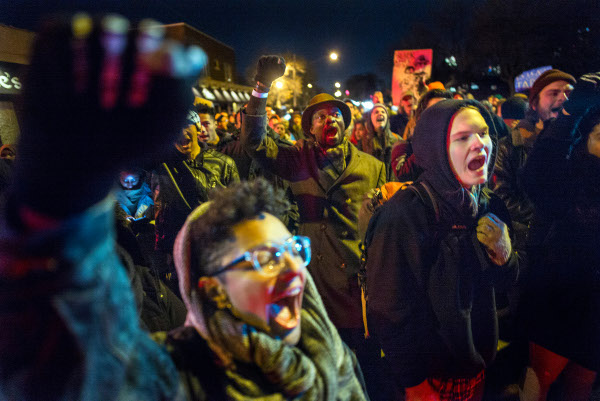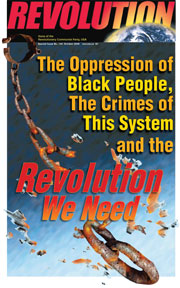Minneapolis Cops Attack Encampment:
Protests Continue to Demand Justice for Jamar Clark
December 7, 2015 | Revolution Newspaper | revcom.us
Revcom.us received the following report from a correspondent who has been in Minneapolis, uniting with the protests against the police murder of Jamar Clark and in the midst of this, taking out to people the movement for revolution—getting out BAsics by Bob Avakian; the video, BA Speaks: REVOLUTION—NOTHING LESS!; Carl Dix’s statement, “Justice for Jamar Clark! Condemn the Racist Assault on Protesters in Minneapolis!,” and promoting revcom.us.

Protesters demand justice outside a police fundraiser, Minneapolis, December 3.
Photo: Richard Tsong-Taatarii/Star Tribune via AP
On November 15, in Minneapolis, Minnesota, 24-year-old Jamar Clark was killed by the police. Many, many witnesses say the cops handcuffed Jamar, knocked him to the ground, and then shot him in the head. Protests against this police murder began immediately and people occupied the area outside the Fourth Police Precinct. Hundreds of people—of all different nationalities, those from the neighborhood, high school and college students, and from many walks of life, joined the occupation, building an encampment community. All kinds of donations came pouring in. People stood together in the face of threats and attacks—from the police and from racist gangs. On November 23, masked white supremacists came into the camp and shot five people. In the face of this, people remained determined to keep the occupation going until their demands were met—including the video of the shooting being released.
Then on the morning of Friday, December 4, at 3 am—after the occupation had been going on for 18 days—the police launched a coordinated attack, using bulldozers and other heavy equipment. Later, the police and media would say that people were given plenty of warning. But in fact, the cops came in, rousted people who were mainly sleeping in tents, and gave them only 10 minutes to clear the area. Those who didn’t wake up or move immediately were doused with cold water and/or arrested. Eight people were arrested. All the tents, signs, food, clothing, and everything else provided by the community to support the encampment were thrown in garbage trucks and destroyed or taken without compensation. The warming fires that gave the occupation its signature look were put out by the fire department and all the kettles and firewood taken. The police and city crews came in and set up concrete barriers in front of the precinct station, along with a steel fence on top.
So-called “community spokespeople” were trotted out to say how “unsafe” the encampment was, how inconvenient it was that one block of Plymouth Avenue was blocked off to traffic, and that the fires were “polluting the neighborhood.” The chief of police announced that protesters would not be allowed to set up similar encampments or block streets for an extended period. And as a prime example of how “unsafe” the occupation was, officials actually cited the shooting of five protesters, all Black men, at the encampment by white supremacists. Four white men were later arrested for the shooting. But what’s highly revealing—especially with regards to WHO’s been responsible for making the encampment unsafe—is that, according to witnesses, police on the scene were more concerned with roping in and suppressing the protesters than capturing the armed attackers.
A protester who was at the scene of the shooting and helped get some of the injured into a SUV to go to the hospital said that when the cops drove up, they were concerned with controlling the crowd, not helping the injured; they were “going after the crowd and pushing us back” and people were saying, “why are you doing this? And then the cops maced some people.” Another woman who was at the scene of the shooting said she asked two cops who were just standing around, what are you going to do about this, and they didn’t do anything and just told her to “call 911”—and that then no police or ambulance came for 15 minutes.
In the face of this vicious attack, protesters didn’t back down and the very next day thousands of people protested in the streets of Minneapolis.
Protests Continue
On Friday, December 4, immediately after the forced eviction, many hundreds of people protested into the afternoon and evening. Three hundred people filled the city hall rotunda to rally against the shutdown and demand more answers about the police shooting of Jamar Clark. Some of the demands people have put forward have been met, like the release of the names of the officers involved. But there are others that have not—like the release of the videotapes of the incident. One organizer said simply, “You have to stop killing us.” Another organizer, Alexander Clark, Jamar’s cousin, added, “The people are tired. It’s time for people to fight back.”
The rally turned into a march that targeted a credit union that financially supports the police union and a law enforcement social function at a restaurant. Another group of 100 people met at a park and demanded the removal of the police union president. Then both groups merged at the headquarters of the police union. Organizers said they would continue “bringing the fight to the Minneapolis Police Department’s doorstep.”
The forces of repression have dismantled the encampment but they have not been able to put an end to the resilience, militancy, and creativity of the people in Minneapolis who are fighting the police murder of Black, Brown, and Native peoples and demanding justice for Jamar Clark.
Volunteers Needed... for revcom.us and Revolution
If you like this article, subscribe, donate to and sustain Revolution newspaper.







